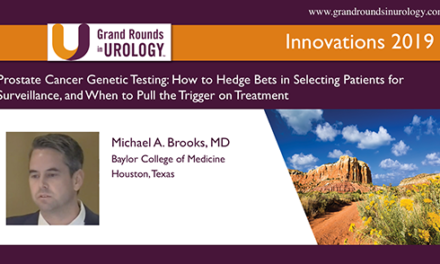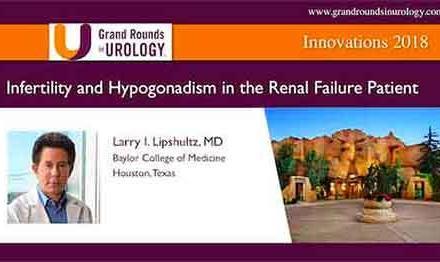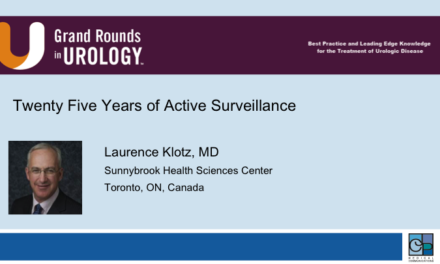Dr. Eastham presented “Radical Prostatectomy: Management of the Primary From Localized to Oligometastatic Disease” at the 26th International Prostate Cancer Update on Thursday, January 21, 2016.
Keywords: prostate cancer, radical prostatectomy
How to cite: Eastham, James A. “Radical Prostatectomy: Management of the Primary From Localized to Oligometastatic Disease.” Grand Rounds in Urology. January 21, 2016. Dec 2024. https://dev.grandroundsinurology.com/radical-prostatectomy-management.
Transcript
Radical Prostatectomy: Management of the Primary From Localized to Oligometastatic Disease
I’ll be talking about the role of radical prostatectomy and prostate cancer, and we’re going to go all the way from primary treatment, from localized, to oligometastatic disease, in this I have nothing to disclose.
This is my first response question. It has to deal with sexual function causing moderate to severe distress in men after radical prostatectomy in two years. You can select the percentage.
Good; a spectrum of answers but the common one was 40-50%, and the next question please.
Which of the following statements are true? They’re 1-5 and I’ll let you read them.
Good; so, some learning to do.
So, I think one of the themes we’ve heard in all of the talks about screening and molecular profiling, and using MRI and all of that is really to identify a cohort of men who really do have low-risk prostate cancer. As Dr. Partin just went through, if you appropriately select patients and appropriately manage these patients, very few will die of prostate cancer.
Most men with low-risk prostate cancer, appropriately managed, will stay low-risk and many will not require treatment throughout their lifetime. At least in our center and many centers around the country, radical prostatectomy has really shifted from the low-risk patient to those this with intermediate and high-risk disease.
As I’ll show shortly, both biochemical and clinical recurrence rates for surgery are acceptable, but we still have to worry about complication rates. That’s one of the areas that I think has promoted active surveillance, is just concerns about erectile dysfunction. Despite what we see on the internet, about 90% of patients after robotic prostatectomy retaining potency, that really is dependent upon your definition of potency. Many men do suffer consequences of over-treatment.
This is data from Memorial, but it’s similar from the Johns Hopkins, and Michigan, and other big centers. If you look at all patients who undergo treatment with radical prostatectomy, most of them are cured. They remain free of biochemical recurrence. That’s certainly stratified in the right graph based on whether they’re low, intermediate, or high-risk. But even then with high-risk disease, about half of them do remain free of biochemical recurrence even 15 years after treatment.
So, certainly surgery is a very effective treatment, and this is as monotherapy. Some men certainly could be salvaged with radiation.
Getting back to the sexual function issue, this is a study by Martin Sand that was a multi-center trial. It looked at patient and partner issues in terms of quality of life after radiation therapy, whether it be external, beam, or brachytherapy, or with surgery, and you can see that the answer to the first question was 40-50% of men and their partners after radical prostatectomy have moderate or severe distress related to erectile dysfunction.
So, despite claims of improved potency with this, that, or the other, it is still a significant issue for many patients and their partners. We do better with urinary function; after surgery it’s less than 10% of patients have moderate to severe distress, and then certainly GI symptoms are rare after surgery.
But, quality of life is a big issue, and over-treatment of course, and why we do all of this risk stratification and trying to cull out the favorable risk patients from having any treatment; it’s all related to risks of treatment versus risks to quality of life. Certainly surgery has changed in my lifetime. When I first started in practice we were focusing on the low-risk patients. Those were the patients we thought we can cure and we did.
But, those were also the patients that probably didn’t need treatment at all, and over the last few years more emphasis has been placed on surgery in intermediate, and high-risk, and even some patients with documents of metastatic disease are now undergoing radical prostatectomy as part of clinical trials looking at multimodal strategies to try to improve outcomes in patients who otherwise would just receive systemic treatment and ultimately have a high likelihood of dying of disease.
So, in terms of high-risk cancers, there’s lots of definitions. This is one of them; it’s the NCCN D’Amico, other criteria, but basically it’s patients these days that have biopsied 8, 9, and 10 diseases. The percentage of patients that have PSAs over 20 that we’re operating on has dropped dramatically because of PSA screening.
There are some men that have higher clinical stages, but most men in this group are defined as high-risk based on their biopsy Gleason score. High-risk simply means if they’re treated with monotherapy they have a higher risk of failing.
Surgery, as I mentioned, was previously used in low- to intermediate-risk disease, and those with high risk were often said to not benefit from an operation. We typically sent those gentlemen to radiation therapy. Some of this was concerns about quality of life, and others were concerned about the efficacy of surgery as a treatment. What we’ve learned over the years is that when we operate on these higher-risk patients, we certainly don’t have more complications in terms of intraoperative or postoperative events in patients who are intermediate versus higher-risk.
The rates of incontinence are similar and the time course of incontinence is similar. Certainly we do have higher rates of erectile dysfunction. Many of these men are at risk for extraprostatic extension, and they likely undergo at least some degree of neurovascular bundle resection. However, it’s not inevitable. Many men with high-risk disease do not have the risk of extraprostatic extension in the area of the neurovascular bundle, and it often is not bilateral.
One of our fellows recently looked at our group of high-risk patients who underwent radical prostatectomy. We defined potency both pre- and postoperatively by an IIEF of 21; that’s a definition that we used. If you look at two years after surgery, almost half the men were able to recover potency. So, not all of these patients are destined to have significant erectile dysfunction just because they’re undergoing surgery in the high-risk setting.
Certainly three years of hormonal therapy, or two years of hormonal therapy and radiation likely will not have higher rates of erectile function preservation than these types of outcomes. So, it’s not inevitable.
The rates of biochemical recurrence are high, as I have shown this slide previously. There are at least 50% over time, but even with biochemical recurrence, many of these patients will do well. Some can be salvaged with radiation therapy, and overall in 15 years only about 20% of these men will die from prostate cancer that were preoperatively high-risk.
So, while the rates of biochemical recurrence are high, surgery certainly has a very acceptable prostate cancer-specific mortality. We frequently use neoadjuvant strategies or concurrence and post-radiation hormonal therapy. What about surgery? There have been a number of studies that have looked at up to eight months of neoadjuvant androgen deprivation therapy for surgery, and while some histologic outcomes have been improved such as positive margin rates, the long-term outcomes are similar.
Someone with high-risk prostate cancer will not benefit from hormonal therapy prior to radical prostatectomy.
We have seen from several studies that adjuvant radiation therapy in selected patients with adverse pathologic features will provide a benefit in terms of survival. Studies are ongoing to determine whether early salvage radiation therapy is beneficial, but certainly patients who have high-risk features at elast should be considered for adjuvant radiation therapy.
The Messing Study, while it’s often criticized, it does show a survival advantage in patients with lymph node involvement at radical prostatectomy for immediate versus delayed hormonal therapy. Certainly chemotherapy and newer agents are being looked at in terms of both neoadjuvant and adjuvant treatment.
For high-risk patients at present, pretreatment, there is no accepted role for neoadjuvant hormonal and neoadjuvant chemotherapy unless it’s part of a clinical trial.
So, those are the considerations in terms of trying to improve outcomes in high-risk patients, is what can we add to surgery to provide a benefit for the patient.
We all know the outcomes of the SWOG study in terms of Docetaxel providing a survival advantage in patients with hormonal refractory prostate cancer, and we have done clinical trials now that have been completed looking at neoadjuvant Docetaxel, plus radical prostatectomy versus radical prostatectomy alone.
That was a study that I had the good fortune to be the PI on. We accrued our 750 patients that were randomized. It’s going to be another two to three years before we get the primary outcome, which is biochemical recurrence. But chemotherapy before surgery is not a standard of care at present, so that’s at least one of the answers to the second question.
There have been studies looking at what’s called androgen annihilation, which is basically looking at some of the newer hormonal therapies in conjunction with a standard hormonal therapy.
This was a study done by Mary Ellen Taplin up in Boston looking at various durations of an LHR antagonist with abiraterone, and they did have some partial responses and a couple of complete responses in terms of tumor eradication.
They defined a near pathologic complete response that I’m not sure the significance of, but again, they had marked reduction in tumor volumes in these patients, and whether this will translate into post-surgery improvements in biochemical or clinical recurrence rates, we’ll have to wait and see. But, certainly strategies such as these are being investigated.
From the standpoint of further investigation how we can better treat these patients, we’re really looking at what we would call a cure paradigm. So, it’s basically using radical prostatectomy as a treatment for the primary tumor and combing that with a combination of systemic agents also in the oligometastatic rate, or oligometastatic setting; some patients will receive radiation therapy to bone lesions, trying to cure patients who are otherwise considered incurable.
This is an experiment; it’s certainly not what we should do on an everyday basis, and the reason for selecting radical prostatectomy rather than radiation therapy for this setting is simply because we can use a non-detectable PSA as an intermediate end point.
So, the goal is to use this combination of treatments and see if the patient, off all treatment, with recovery of hormonal therapy, can we keep their PSA non-detectable? And it’s basically using hormonal therapy and other systemic agent, whatever you want to think of, and then radical prostatectomy.
This also sets the stage for looking at this in patients with oligometastatic disease. There certainly is rationale to consider this in prostate cancer. We do have evidence in other cancers, renal cell, ovarian, colon, et cetera, so we are now looking at using radical prostatectomy in men who actually have documented metastatic disease.
There have been studies, or retrospective reviews of data that have looked at patients who have metastatic disease, and for one reason or another a small percentage of those patients were treated, had their primary treat it with either radiation or surgery, and they tended to do better. Now, obviously there’s selection bias, et cetera, but it does suggest that treatment of the primary cancer may improve outcomes even in patients with metastatic disease.
This is a very nice study done by Axel Heidenreich and his group looking at patients who did or did not undergo radical prostatectomy in the setting of oligometastatic disease, so less than or equal to three bone metastases. They had to achieve a non-detectable PSA on hormonal therapy.
It is not randomized, so there was some selection bias, but if you look at those patients who underwent radical prostatectomy, there time to progression was longer, their time to castrate resistance disease was longer, their cancer-specific survival was better, and the requirement for local palliation, meaning other surgical interventions, nephrostomy tubes, et cetera, was much better.
So, again suggesting–small study–but suggesting that treatment of the primary cancer can provide a benefit in selected patients.
I’m not sure we’ll quite come to this, this is from one our tests for cancer patients, but certainly there are some groups that are doing retroperitoneal lymph node dissection with pelvic lymph node dissection, with radical prostatectomy, in combination with some systemic therapy to try to cure patients who are previously selected just for hormonal therapy, and whether or not this will prove beneficial to these patients, that’s being studied.
In terms of treating prostate cancer, I think radical prostatectomy is an excellent treatment for intermediate and high-risk disease. It’s being evaluated in patients with very high risk in oligometastatic disease, certainly adjuvant or early salvage radiation therapy is an option in patients who do have biochemical recurrence, and we certainly have to improve our multidisciplinary approaches to these high-risk patients in order to improve their outcomes, and I encourage all of you to support the clinical trials that are available in this setting.
ABOUT THE AUTHOR
James A. Eastham, MD, FACS, is the Peter T. Scardino Chair in Oncology and Chief of the Urology Service in the Department of Surgery at Memorial Sloan-Kettering Cancer Center in New York. Dr. Eastham received his medical degree from the University of Southern California, Los Angeles. He completed an Internship in General Surgery and a Residency in Urology at Los Angeles County+USC Medical Center. He went on to complete a Fellowship in Urologic Oncology at Baylor College of Medicine in Houston, Texas. Prior to his appointment at Memorial Sloan-Kettering Cancer Center, Dr. Eastham was an Assistant and Associate Professor in the Department of Urology at Louisiana State University in Shreveport and Chief of Urology at Overton-Brooks Veterans Administration Medical Center in Louisiana.
Dr. Eastham’s research has focused on the prevention and treatment of prostate cancer, and he has a particular interest in improving oncologic and quality-of-life outcomes after radical prostatectomy. He has authored or co-authored over 300 articles which have appeared in peer-reviewed journals such as the Journal of the American Medical Association, the Journal of Urology, the Journal of Clinical Oncology, Urology, and Transplantation. In addition, he has authored numerous book chapters, reviews, monographs, and abstracts. He is a Fellow of the American College of Surgeons and a member of several professional societies, including the American Urologic Association, the Society of Urologic Oncology, and the Societé Internationale D’Urologie.





